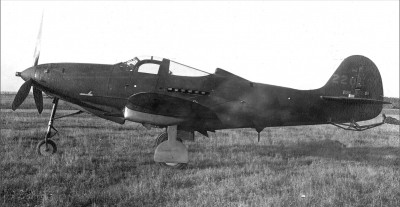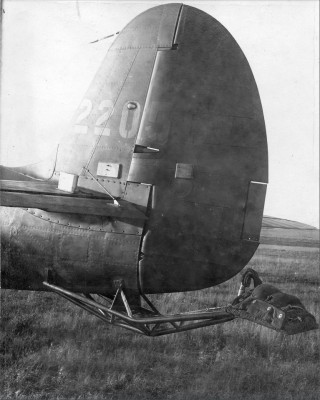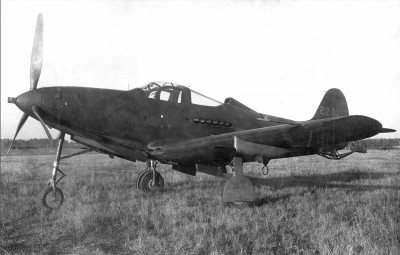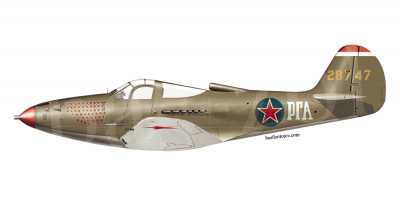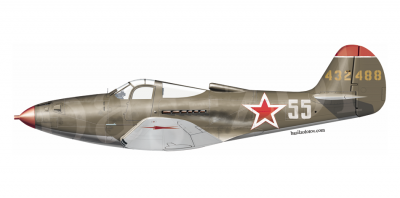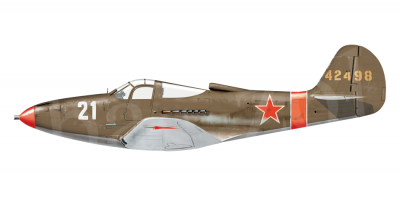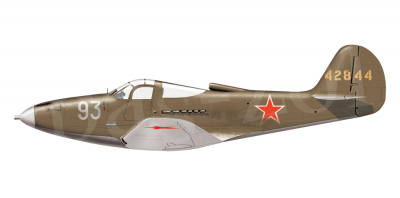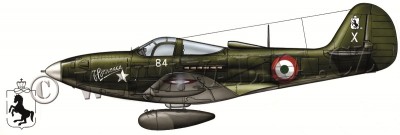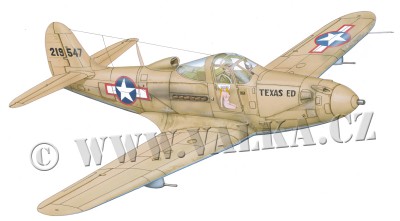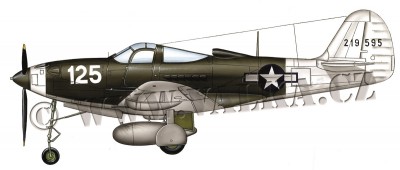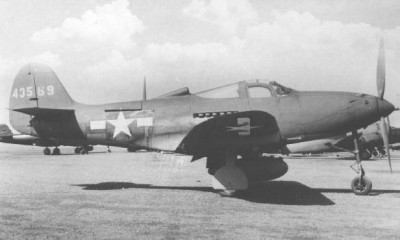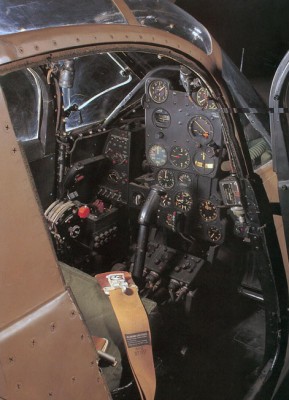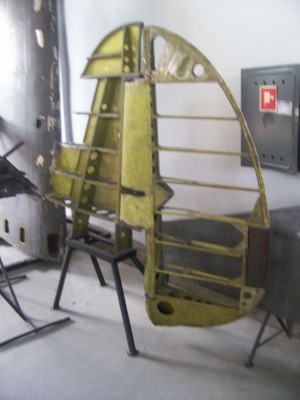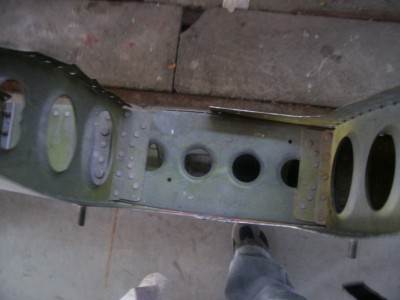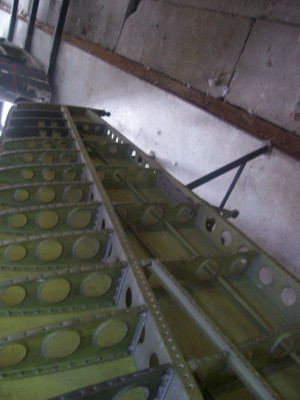| Název: Name: | Bell P-39Q-5-BE Airacobra | Bell P-39Q-5-BE Airacobra |
| Originální název: Original Name: | Bell P-39Q-5-BE Airacobra | |
| Kategorie: Category: | stíhací letoun | fighter aeroplane |
| Výrobce: Producer: | DD.MM.1943-DD.MM.194R Bell Aircraft Corp., Buffalo, New York | |
| Období výroby: Production Period: | DD.MM.1943-DD.MM.194R | |
| Vyrobeno kusů: Number of Produced: | 4905 všech subverzí | |
| První vzlet: Maiden Flight: | DD.MM.RRRR | |
| Osádka: Crew: | 1 | |
| Základní charakteristika: Basic Characteristics: | ||
| Vzlet a přistání: Take-off and Landing: | CTOL - konvenční vzlet a přistání | CTOL - conventional take-off and landing |
| Uspořádání křídla: Arrangement of Wing: | jednoplošník | monoplane |
| Uspořádání letounu: Aircraft Concept: | klasické | conventional |
| Podvozek: Undercarriage: | pevný | fixed |
| Přistávací zařízení: Landing Gear: | kola | wheels |
| Technické údaje: Technical Data: | ||
| Hmotnost prázdného letounu: Empty Weight: | 2561 kg | 5645 lb |
| Vzletová hmotnost: Take-off Weight: | 3447 kg | 7600 lb |
| Maximální vzletová hmotnost: Maximum Take-off Weight: | 3765 kg | 8300 lb |
| Rozpětí: Wingspan: | 10.36 m | 34ft |
| Délka: Length: | 9.19 m | 30ft 2in |
| Výška: Height: | 3.78 m | 12ft 5in |
| Plocha křídla: Wing Area: | 19.79 m2 | 213 ft2 |
| Plošné zatížení: Wing Loading: | ? kg/m2 | ? lb/ft2 |
| Pohon: Propulsion: | ||
| Kategorie: Category: | pístový | piston |
| Počet motorů: Number of Engines: | 1 | |
| Typ: Type: | Allison V-1710-85 o vzletovém výkonu 895 kW | Allison V-1710-85, take-off power 1200 hp |
| Objem palivových nádrží: Fuel Tank Capacity: | ? 662 l přídavná nádrž | ? 145.7 Imp gal drop tank |
| Výkony: Performance: | ||
| Maximální rychlost: Maximum Speed: | 605.1 km/h v 4572 m | 376 mph in 15000 ft |
| Cestovní rychlost: Cruise Speed: | ? km/h v ? m | ? mph in ? ft |
| Rychlost stoupání: Climb Rate: | ? m/s | ? ft/min |
| Čas výstupu na výšku: Time to Climb to: | 8.5 min do 6096 m | 8.5 min to 20000 ft |
| Operační dostup: Service Ceiling: | 10668 m | 35000 ft |
| Dolet: Range: | 844.9 2) km | 5252) mi |
| Maximální dolet: Maximum Range: | 1730 3) km | 10753) mi |
| Výzbroj: Armament: | 1x pevný 37 mm kanón Oldsmobile M4 (T9) v ose vrtule s 30 náboji 4x pevný 12,7mm kulomet Browning M2 226kg bomba | 1x fixed 1.46 inch Oldsmobile M4 (T9) cannon with 30 rounds 4x fixed .50 Browning M2 machine gun 500 lb bomb |
| Uživatelské státy: User States: | | |
| Poznámka: Note: | 1) 531 km/h v 1524 m, 575 km/h v 3048 m 2) max. dolet bez přídané nádrže 3) s přídavnou nádrží | 1) 330 mph at 5000 feet, 357 mph at 10,000 feet 2) Maximum range (clean) 3) with drop tank |
| Zdroje: Sources: | Pelletier, A. J.: Bell Aircraft Since 1935, Putnam, London 1992. ISBN 1-55750-056-8 Bartoszewski, Piotr: Samolot myśliwski P-39 Airacobra, TBiU Nr.85, Warszawa 1983 McDowell, Ernest: P-39 Airacobra in Action, Aircraft No.43. Squadron/Signal Publications, Carrollton 1980. ISBN 0-89747-102-4 Dorr, Robert F., Scutts, Jerry C.: Bell P-39 Airacobra. Crowood Press Ltd., Marlborough 2000. ISBN 1-86126-348-1 Juszczak, Artur, Pęczkowski, Robert: Bell P-39 Airacobra. Mushroom Model Publications, Sandomierz 2003. ISBN 83-916327-9-2 http://home.att.net/~jbaugher1/p39_15.html http://www.aerofiles.com/_bell.html http://en.wikipedia.org/wiki/P-39_Airacobra | |
Bell P-39Q Airacobra
The P-39Q was the latest version of the Airacobra and also the most numerous. From the previous versions, the Q differed in armament - 7.62 mm machine guns in the wings, used on previous types, were removed and replaced by two half-gun Brownings in holsters under the wing. These machine guns each had 300 rounds. American pilots were satisfied with this change, because the original weapons were ineffective, the Russians, who got most of the machines, but mostly removed the holsters. All machines were powered by the same engine, Allison V-1710-85 (E19) as the previous version - P-39N.
The individual production units again differed from each other in various equipment, from fuel tanks to armor. P-39Q-1-BE had a 329 liter tank, as P-39N -5, but at the same time they got back the original armor according to the variant P-39N-1. The P-39Q-5-BE (Model 26Q-5) returned to the light armor of the N-5 and 421 liter tank. These machines also received an A-1 bomb sight before delivery to the front units. For the P-39Q-10-BE series (Model 26Q-10), the tank capacity increased to 455 l and the weight of the armor decreased slightly. The propeller was automatically adjusted to the gas, the oil system was additionally insulated against the cold and the engine was mounted on rubber silent blocks. The first P-39Q-10-BE were handed over in July 1943, a total of 705 pieces were built, but another 995 with assigned numbers 42-21251 to 22245 was completed as P-63E-1 Kingcobra.
The P-39Q-15-BE (Model 26Q-15) differed from the previous ones by minor modifications to the equipment, which were to improve the resistance of the machine gun mount, reinforcement of some other components and relocation of the battery solenoid. In this form, 1000 pieces were created and were delivered from August 1943. Series Q-20 (Model 26Q-20) more or less coincided, only for some machines were released cases with machine guns under the wings. P-39Q-21-BE received a four-bladed propeller Aeroproducts, P-39Q-25-BE (Model 26Q-25) also had a reinforced construction of the tail and horizontal surfaces. All 700 Q-25s were delivered to the Soviet Union and therefore did not have machine guns under the wings. However, because the four-bladed propeller worsened the overall longitudinal stability, the P-39Q-30-BE returned the original, three-bladed propeller.
As with the versions D and N there are now subversions for ground support and reconnaissance - P-39Q-2-BE were five Q-1s, modified with the usual set of photographic equipment. 148 Q-5 machines were modified to P-39Q-6-BE, again by installing cameras in the fuselage behind the wings. The same was out of eight Q-10s, now designated Q-11s. On July 25, 1944, production was terminated by the 9558th machine.
The P-39Q pair was modified to two-seater advanced training aircraft, designated RP-39Q and after 1944 TP-39Q. The second cockpit was placed in front, in places where the cannon was originally located. This new space had only basic equipment and served as an instructor who could talk to the student through the intercom. Under the fuselage, two-seater machines got a new keel area. The first was modified from the P-39Q-5 42-20024 and first left the hangar on September 16, 1943, under the designation TP-39Q-5. Another 12 machines (44-3879, 3885, 3886, 3887, 3889, 3895, 3897, 3905, 3906, 3908, 3917 and 3918) originated from P-39Q-20 as RP-39Q-22, the keel surface had a slightly different shape than TP-39Q-5.
The first P-39Qs were handed over to the army in July 1943, the last in August 1944. Most of them ended up in Russian hands, the few that remained with the US Air Force served for example at 332. fighter group, which deployed 75 P-39Q since February 1944 in Italy. After two months, however, they were replaced by P-47 and P-39 definitely left the armament of American troops.
Source:
Pelletier, A. J .: Bell Aircraft Since 1935, Putnam, London 1992.ISBN 1-55750-056-8
Bartoszewski, Piotr: Thought Samolot P-39 Airacobra, TBiU Nr.85, Warsaw 1983
McDowell, Ernest: P-39 Airacobra in Action, Aircraft No.43. Squadron/Signal Publications, Carrollton 1980. ISBN 0-89747-102-4
Dorr, Robert F., Scutts, Jerry C .: Bell P-39 Airacobra. Crowood Press Ltd., Marlborough 2000. ISBN 1-86126-348-1
Juszczak, Artur, Pęczkowski, Robert: Bell P-39 Airacobra. Mushroom Model Publications, Sandomierz 2003. ISBN 83-916327-9-2
http://home.att.net/~jbaugher1/p39_15.html
http://www.aerofiles.com/_bell.html
http://en.wikipedia.org/wiki/P-39_Airacobra
The individual production units again differed from each other in various equipment, from fuel tanks to armor. P-39Q-1-BE had a 329 liter tank, as P-39N -5, but at the same time they got back the original armor according to the variant P-39N-1. The P-39Q-5-BE (Model 26Q-5) returned to the light armor of the N-5 and 421 liter tank. These machines also received an A-1 bomb sight before delivery to the front units. For the P-39Q-10-BE series (Model 26Q-10), the tank capacity increased to 455 l and the weight of the armor decreased slightly. The propeller was automatically adjusted to the gas, the oil system was additionally insulated against the cold and the engine was mounted on rubber silent blocks. The first P-39Q-10-BE were handed over in July 1943, a total of 705 pieces were built, but another 995 with assigned numbers 42-21251 to 22245 was completed as P-63E-1 Kingcobra.
The P-39Q-15-BE (Model 26Q-15) differed from the previous ones by minor modifications to the equipment, which were to improve the resistance of the machine gun mount, reinforcement of some other components and relocation of the battery solenoid. In this form, 1000 pieces were created and were delivered from August 1943. Series Q-20 (Model 26Q-20) more or less coincided, only for some machines were released cases with machine guns under the wings. P-39Q-21-BE received a four-bladed propeller Aeroproducts, P-39Q-25-BE (Model 26Q-25) also had a reinforced construction of the tail and horizontal surfaces. All 700 Q-25s were delivered to the Soviet Union and therefore did not have machine guns under the wings. However, because the four-bladed propeller worsened the overall longitudinal stability, the P-39Q-30-BE returned the original, three-bladed propeller.
As with the versions D and N there are now subversions for ground support and reconnaissance - P-39Q-2-BE were five Q-1s, modified with the usual set of photographic equipment. 148 Q-5 machines were modified to P-39Q-6-BE, again by installing cameras in the fuselage behind the wings. The same was out of eight Q-10s, now designated Q-11s. On July 25, 1944, production was terminated by the 9558th machine.
The P-39Q pair was modified to two-seater advanced training aircraft, designated RP-39Q and after 1944 TP-39Q. The second cockpit was placed in front, in places where the cannon was originally located. This new space had only basic equipment and served as an instructor who could talk to the student through the intercom. Under the fuselage, two-seater machines got a new keel area. The first was modified from the P-39Q-5 42-20024 and first left the hangar on September 16, 1943, under the designation TP-39Q-5. Another 12 machines (44-3879, 3885, 3886, 3887, 3889, 3895, 3897, 3905, 3906, 3908, 3917 and 3918) originated from P-39Q-20 as RP-39Q-22, the keel surface had a slightly different shape than TP-39Q-5.
The first P-39Qs were handed over to the army in July 1943, the last in August 1944. Most of them ended up in Russian hands, the few that remained with the US Air Force served for example at 332. fighter group, which deployed 75 P-39Q since February 1944 in Italy. After two months, however, they were replaced by P-47 and P-39 definitely left the armament of American troops.
Source:
Pelletier, A. J .: Bell Aircraft Since 1935, Putnam, London 1992.ISBN 1-55750-056-8
Bartoszewski, Piotr: Thought Samolot P-39 Airacobra, TBiU Nr.85, Warsaw 1983
McDowell, Ernest: P-39 Airacobra in Action, Aircraft No.43. Squadron/Signal Publications, Carrollton 1980. ISBN 0-89747-102-4
Dorr, Robert F., Scutts, Jerry C .: Bell P-39 Airacobra. Crowood Press Ltd., Marlborough 2000. ISBN 1-86126-348-1
Juszczak, Artur, Pęczkowski, Robert: Bell P-39 Airacobra. Mushroom Model Publications, Sandomierz 2003. ISBN 83-916327-9-2
http://home.att.net/~jbaugher1/p39_15.html
http://www.aerofiles.com/_bell.html
http://en.wikipedia.org/wiki/P-39_Airacobra
Reklama
Airacobra was known to have a tendency to fall into an almost flat corkscrew during the so-called drag, which in less experienced pilots usually ended in fatal accidents. Therefore, in the Soviet Union from 16.10.-19.10.1943 tests were carried out on models P-39Q-10 (Art. No. 42-20561) for the behavior of the aircraft when falling into a corkscrew and for possible solutions to this undesirable phenomenon.
Chief Test Pilot of the 3rd Department of the Red Army Air Research Institute Major Vladimir Jefremovich Golofastov and other test pilots proved during the tests that the American machine is possible, at a sufficient height, always safely come out of the corkscrew. It was essential not to panic when the plane fell into the corkscrew and not to try to remove it right at the beginning by pushing the lever, with the pedals in the neutral position. It was necessary to leave the aircraft until it made six to seven corkscrews and then slowly push the control lever and pedal in the direction of the corkscrew. At the same time, the results of the experiments showed that it is necessary to pay attention to the thorough balancing of the aircraft before takeoff, which could to some extent also contribute to a lower chance of the machine falling into the corkscrew.
At the same time, the so-called anti-drill device, developed by the Aviation Research Institute, was also tested as part of the tests. It was a parachute with an area of 3m 2 placed on a tubular structure mounted under the tail surface of the aircraft and controlled from the cockpit. According to the test pilot Major Golofastov, who tested the modified machine for an hour of flight time, it was an effective device, as the opening of the parachute was able to give the aircraft enough torque to taking the aircraft out of the corkscrew. Despite the favorable evaluation, this device remained only in the prototype and was not mounted on serial aircraft.
Later, tests were also carried out on the P-39Q-21/25, which was a version with a four-bladed propeller by Aeroproducts. In this case, the shape of the structure holding the parachute was slightly changed, which was placed even closer to the fuselage and was a bit shorter than the previous modification. It is not known that this device has been installed in series on this production series.
Act after resolutions of summer traces on the trunk of the import aircraft Aerokobra P-39Q-10 with dvigatelj Allison V-1710-85, with undercover pajemjotami, caliber 12.7 mm, NII VVS KA, 1943
P-39Q-10 s protivývrtkovým padákom
P-39Q-21/25 s protivývrtkovým padákom
Chief Test Pilot of the 3rd Department of the Red Army Air Research Institute Major Vladimir Jefremovich Golofastov and other test pilots proved during the tests that the American machine is possible, at a sufficient height, always safely come out of the corkscrew. It was essential not to panic when the plane fell into the corkscrew and not to try to remove it right at the beginning by pushing the lever, with the pedals in the neutral position. It was necessary to leave the aircraft until it made six to seven corkscrews and then slowly push the control lever and pedal in the direction of the corkscrew. At the same time, the results of the experiments showed that it is necessary to pay attention to the thorough balancing of the aircraft before takeoff, which could to some extent also contribute to a lower chance of the machine falling into the corkscrew.
At the same time, the so-called anti-drill device, developed by the Aviation Research Institute, was also tested as part of the tests. It was a parachute with an area of 3m 2 placed on a tubular structure mounted under the tail surface of the aircraft and controlled from the cockpit. According to the test pilot Major Golofastov, who tested the modified machine for an hour of flight time, it was an effective device, as the opening of the parachute was able to give the aircraft enough torque to taking the aircraft out of the corkscrew. Despite the favorable evaluation, this device remained only in the prototype and was not mounted on serial aircraft.
Later, tests were also carried out on the P-39Q-21/25, which was a version with a four-bladed propeller by Aeroproducts. In this case, the shape of the structure holding the parachute was slightly changed, which was placed even closer to the fuselage and was a bit shorter than the previous modification. It is not known that this device has been installed in series on this production series.
Act after resolutions of summer traces on the trunk of the import aircraft Aerokobra P-39Q-10 with dvigatelj Allison V-1710-85, with undercover pajemjotami, caliber 12.7 mm, NII VVS KA, 1943
Bondarenko, N. A .: Test pilot, Our Army, Prague 1978
Kotelnikov, V .: Realii lend-liza, monthly Aviacija i Kosmonavtika, roč. 1996, No. 2, pp. 38-45
https://coollib.com/b/260697/read#t15
https://www.t akredit.ru/base/2012/12/golofastov-v-e/
| Period | World War Two [1939-1945] |
| Producer | - |
| Type | - |
| Camouflage | Standardní vojenská |
| Country |  |
| Pilot | - |
| Production No. | 42-20561 |
| Serial No. / Evidence No. | - |
| Tactical Marking / Imatriculation | - |
| Name | - |
| Unit | - |
| Base | - |
| Date (DD.MM.RRRR) | DD.MM.RRRR |
| Author | - |
| Print size / 300 DPI | - |
| Published with authors permit | - |
| Author Website | - |
| Period | World War Two [1939-1945] |
| Producer | - |
| Type | - |
| Camouflage | Standardní vojenská |
| Country |  |
| Pilot | - |
| Production No. | 42-20561 |
| Serial No. / Evidence No. | - |
| Tactical Marking / Imatriculation | - |
| Name | - |
| Unit | - |
| Base | - |
| Date (DD.MM.RRRR) | DD.MM.RRRR |
| Author | - |
| Print size / 300 DPI | - |
| Published with authors permit | - |
| Author Website | - |
| Period | World War Two [1939-1945] |
| Producer | - |
| Type | - |
| Camouflage | Standardní vojenská |
| Country |  |
| Pilot | - |
| Production No. | 42-20561 |
| Serial No. / Evidence No. | - |
| Tactical Marking / Imatriculation | - |
| Name | - |
| Unit | - |
| Base | - |
| Date (DD.MM.RRRR) | DD.MM.RRRR |
| Author | - |
| Print size / 300 DPI | - |
| Published with authors permit | - |
| Author Website | - |
| Period | - |
| Producer | - |
| Type | - |
| Camouflage | - |
| Country | - |
| Pilot | - |
| Production No. | - |
| Serial No. / Evidence No. | - |
| Tactical Marking / Imatriculation | - |
| Name | - |
| Unit | - |
| Base | - |
| Date (DD.MM.RRRR) | DD.MM.RRRR |
| Author | - |
| Print size / 300 DPI | - |
| Published with authors permit | - |
| Author Website | - |
P-39Q-10 s protivývrtkovým padákom
| Period | - |
| Producer | - |
| Type | - |
| Camouflage | - |
| Country | - |
| Pilot | - |
| Production No. | - |
| Serial No. / Evidence No. | - |
| Tactical Marking / Imatriculation | - |
| Name | - |
| Unit | - |
| Base | - |
| Date (DD.MM.RRRR) | DD.MM.RRRR |
| Author | - |
| Print size / 300 DPI | - |
| Published with authors permit | - |
| Author Website | - |
P-39Q-21/25 s protivývrtkovým padákom
Bell P-39Q-15-BE Airacobra 42-8747, 16. GIAP, summer 1944, machine of G. A. Reckalovov.
Instead of a tactical number, the aircraft carries the pilot's initials (RGA), the stars on the bow symbolize Rečkalov's victory at that time.
Bell P-39 Airacobra Side view by Basil Zolotov
Source : https://basilzolotov.com
Instead of a tactical number, the aircraft carries the pilot's initials (RGA), the stars on the bow symbolize Rečkalov's victory at that time.
Bell P-39 Airacobra Side view by Basil Zolotov
| Period | - |
| Producer | - |
| Type | - |
| Camouflage | - |
| Country | - |
| Pilot | - |
| Production No. | - |
| Serial No. / Evidence No. | - |
| Tactical Marking / Imatriculation | - |
| Name | - |
| Unit | - |
| Base | - |
| Date (DD.MM.RRRR) | DD.MM.RRRR |
| Author | - |
| Print size / 300 DPI | - |
| Published with authors permit | - |
| Author Website | - |
Source : https://basilzolotov.com
Bell P-39Q-25 Airacobra “White 55 ″ 44-32488, 16. GIAP, Stefanesti Airport 1944. Pilot G. Golubyev.
Bell P-39 Airacobra Side view by Basil Zolotov
Source : https://basilzolotov.com
Bell P-39 Airacobra Side view by Basil Zolotov
| Period | - |
| Producer | - |
| Type | - |
| Camouflage | - |
| Country | - |
| Pilot | - |
| Production No. | - |
| Serial No. / Evidence No. | - |
| Tactical Marking / Imatriculation | - |
| Name | - |
| Unit | - |
| Base | - |
| Date (DD.MM.RRRR) | DD.MM.RRRR |
| Author | - |
| Print size / 300 DPI | - |
| Published with authors permit | - |
| Author Website | - |
Source : https://basilzolotov.com
Reklama
Bell P-39Q-15 Airacobra “White 21″ 44-2498, Command Squadron 72. GIAP, personal machine regiment commander P. F. Zavaruchin. The red propeller cone and the white lined stripe on the fuselage were the identifying features of the 72nd GIAP.
Bell P-39 Airacobra Side view by Basil Zolotov
Source : https://basilzolotov.com
Bell P-39 Airacobra Side view by Basil Zolotov
| Period | - |
| Producer | - |
| Type | - |
| Camouflage | - |
| Country | - |
| Pilot | - |
| Production No. | - |
| Serial No. / Evidence No. | - |
| Tactical Marking / Imatriculation | - |
| Name | - |
| Unit | - |
| Base | - |
| Date (DD.MM.RRRR) | DD.MM.RRRR |
| Author | - |
| Print size / 300 DPI | - |
| Published with authors permit | - |
| Author Website | - |
Source : https://basilzolotov.com
Bell P-39Q-15-LO Airacobra "White 93" 44-2844, personal machine of Lieutenant Dimitri A. Kalinin, 2nd Air Force, 7th Fighter Corps, 20th Fighter Division, 508.IAP, 1st Ukrainian Front He flew from Turbia Airport in Poland in August 1944. The machine is camouflaged with the standard USAAF Olive Drab paint with Neutral Gray bottoms.
Bell P-39 Airacobra Side view by Basil Zolotov
Source : https://basilzolotov.com
Bell P-39 Airacobra Side view by Basil Zolotov
| Period | - |
| Producer | - |
| Type | - |
| Camouflage | - |
| Country | - |
| Pilot | - |
| Production No. | - |
| Serial No. / Evidence No. | - |
| Tactical Marking / Imatriculation | - |
| Name | - |
| Unit | - |
| Base | - |
| Date (DD.MM.RRRR) | DD.MM.RRRR |
| Author | - |
| Print size / 300 DPI | - |
| Published with authors permit | - |
| Author Website | - |
Source : https://basilzolotov.com
P-39Q from the armament of the 4th Stormo of the Italian Allied Air Force (Co-Belligerent) in 1945.
Published with authors permit
| Period | World War Two [1939-1945] |
| Producer | Bell |
| Type | Bell P-39Q Airacobra |
| Camouflage | Standardní vojenská |
 Olivově zelená / Olive Green Olivově zelená / Olive Green Šedá světlá / Light Grey Šedá světlá / Light Grey |
|
| Country |  |
| Pilot | - |
| Production No. | - |
| Serial No. / Evidence No. | - |
| Tactical Marking / Imatriculation | X84 |
| Name | - |
| Unit | - |
| Base | - |
| Date (DD.MM.RRRR) | DD.MM.1945 |
| Author | Zbyněk Válka |
| Print size / 300 DPI | A4 |
| Published with authors permit | Published with authors permit |
| Author Website | - |
Published with authors permit
This post has not been translated to English yet. Please use the TRANSLATE button above to see machine translation of this post.
| Period | World War Two [1939-1945] |
| Producer | Bell |
| Type | Bell P-39Q Airacobra |
| Camouflage | Standardní vojenská |
 Olivově zelená / Olive Green Olivově zelená / Olive Green Šedá světlá / Light Grey Šedá světlá / Light Grey |
|
| Country |  |
| Pilot | - |
| Production No. | - |
| Serial No. / Evidence No. | - |
| Tactical Marking / Imatriculation | - |
| Name | - |
| Unit | - |
| Base | - |
| Date (DD.MM.RRRR) | DD.MM.1944 |
| Author | Zbyněk Válka |
| Print size / 300 DPI | A4 |
| Published with authors permit | Published with authors permit |
| Author Website | - |
Aircobra patřící 10. skupině (10° Gruppo) Italského spojeneckého letectva (Italian Co-Belligerent Air Force). Italské Airacobry byly používány zejména v roli bitevníků, když od konce léta 1944 útočily na německé autokolony. Zobrazený stroj koncem roku 1944 operoval z letiště Galatina u Lecce. Letoun nese kamufláž sestávající z tmavé zelené na horních a bočních plochách světle šedé na spodních plochách. Marking na přídi je pozůstatkem z doby služby u USAAF.
Published with authors permit
This post has not been translated to English yet. Please use the TRANSLATE button above to see machine translation of this post.
| Period | World War Two [1939-1945] |
| Producer | Bell |
| Type | Bell P-39Q Airacobra |
| Camouflage | Standardní vojenská |
 Modrá světlá / Light Blue Modrá světlá / Light Blue Písková / Sand Písková / Sand |
|
| Country |  |
| Pilot | - |
| Production No. | - |
| Serial No. / Evidence No. | 42-19547 |
| Tactical Marking / Imatriculation | - |
| Name | Texas Ed |
| Unit | 21. stíhací skupina [1944-1946] |
| Base | - |
| Date (DD.MM.RRRR) | DD.MM.1943 |
| Author | Zbyněk Válka |
| Print size / 300 DPI | A4 |
| Published with authors permit | Published with authors permit |
| Author Website | - |
Bell P-39Q Airacobra s/n 42-19547 "Texas Ed", 46th Fighter Squadron, 21st Fighter Group, 7th Army Air Force, atol Canton, léto 1943. Pilot tohoto stroje Capt. Felix P. Scott později (v lednu 1944) na tomto letounu docílil nočního sestřelu bombardéru Nell. To už však stroj nesl pozměněný marking. V létě 1943 Airacobry této jendotky nosily nátěr Coral Sand (korálová písková) na horních a bočních plochách a barvou Sky Blue (nebeská modř) na spodních plochách. V průběhu léta 1943 také došlo ke změně kruhových výsostných znaků na typ s "křidélky". U tohoto letounu však nebyl opraven znak na spodní ploše křídla, takže po celou dobu služby letounu zůstal zespodu znak staršího typu.
Published with authors permit
Bell P-39Q Airacobra (42-19595) from the 362nd Fighter Squadron, which operated from bases in California in 1943.
Published with authors permit
Published with authors permit
| Period | World War Two [1939-1945] |
| Producer | Bell |
| Type | Bell P-39Q Airacobra |
| Camouflage | Standardní vojenská |
 Šedá světlá / Light Grey Šedá světlá / Light Grey Olivově zelená / Olive Green Olivově zelená / Olive Green Bílá / White Bílá / White |
|
| Country |  |
| Pilot | - |
| Production No. | - |
| Serial No. / Evidence No. | 42-19595 |
| Tactical Marking / Imatriculation | 125 |
| Name | - |
| Unit | 362. stíhací peruť [1942-1946] |
| Base | - |
| Date (DD.MM.RRRR) | DD.MM.1943 |
| Author | Zbyněk Válka |
| Print size / 300 DPI | A4 |
| Published with authors permit | Published with authors permit |
| Author Website | - |
Published with authors permit
| Period | World War Two [1939-1945] |
| Producer | Bell |
| Type | Bell P-39Q Airacobra |
| Camouflage | Standardní vojenská |
 Šedá světlá / Light Grey Šedá světlá / Light Grey Olivově zelená / Olive Green Olivově zelená / Olive Green Bílá / White Bílá / White |
|
| Country |  |
| Pilot | - |
| Production No. | - |
| Serial No. / Evidence No. | 42-19595 |
| Tactical Marking / Imatriculation | 125 |
| Name | - |
| Unit | 362. stíhací peruť [1942-1946] |
| Base | - |
| Date (DD.MM.RRRR) | DD.MM.1943 |
| Author | Zbyněk Válka |
| Print size / 300 DPI | A4 |
| Published with authors permit | Published with authors permit |
| Author Website | - |
Published with authors permit
Bell P-39Q-1 Airacobra ("Sad Sack", 42-19510), which in 1944 has served with the 72nd Fighter Squadron from the assembly 21st Fighter Group on the Makin atoll in the Pacific. The pilot of the aircraft was captain James van Nada..
Published with authors permit
| Period | World War Two [1939-1945] |
| Producer | Bell |
| Type | Bell P-39Q Airacobra |
| Camouflage | Standardní vojenská |
 Olivově zelená / Olive Green Olivově zelená / Olive Green |
|
| Country |  |
| Pilot | - |
| Production No. | - |
| Serial No. / Evidence No. | 42-19510 |
| Tactical Marking / Imatriculation | - |
| Name | Sad Sack |
| Unit | 21. stíhací skupina [1944-1946] |
| Base | - |
| Date (DD.MM.RRRR) | DD.MM.1944 |
| Author | Zbyněk Válka |
| Print size / 300 DPI | A4 |
| Published with authors permit | Published with authors permit |
| Author Website | - |
Published with authors permit
The Bell P-39Q-20-BE (serial number 44-3569, listed as 43569 on the SOP) was to serve with the 71st Fighter Group, and was lost on September 2, 1944, New Georgia.
(USAF)
| Period | - |
| Producer | - |
| Type | - |
| Camouflage | - |
| Country | - |
| Pilot | - |
| Production No. | - |
| Serial No. / Evidence No. | - |
| Tactical Marking / Imatriculation | - |
| Name | - |
| Unit | - |
| Base | - |
| Date (DD.MM.RRRR) | - |
| Author | - |
| Print size / 300 DPI | - |
| Published with authors permit | - |
| Author Website | - |
(USAF)
A view of the P-39Q cockpit
| Period | - |
| Producer | - |
| Type | - |
| Camouflage | - |
| Country | - |
| Pilot | - |
| Production No. | - |
| Serial No. / Evidence No. | - |
| Tactical Marking / Imatriculation | - |
| Name | - |
| Unit | - |
| Base | - |
| Date (DD.MM.RRRR) | - |
| Author | - |
| Print size / 300 DPI | - |
| Published with authors permit | - |
| Author Website | - |
SOP construction
| Period | - |
| Producer | - |
| Type | - |
| Camouflage | - |
| Country | - |
| Pilot | - |
| Production No. | - |
| Serial No. / Evidence No. | - |
| Tactical Marking / Imatriculation | - |
| Name | - |
| Unit | - |
| Base | - |
| Date (DD.MM.RRRR) | - |
| Author | - |
| Print size / 300 DPI | - |
| Published with authors permit | - |
| Author Website | - |
Center of the GTC - this part went through the fuselage - I apologize that there will be no overall view of the GTC, but the photo failed.
| Period | - |
| Producer | - |
| Type | - |
| Camouflage | - |
| Country | - |
| Pilot | - |
| Production No. | - |
| Serial No. / Evidence No. | - |
| Tactical Marking / Imatriculation | - |
| Name | - |
| Unit | - |
| Base | - |
| Date (DD.MM.RRRR) | - |
| Author | - |
| Print size / 300 DPI | - |
| Published with authors permit | - |
| Author Website | - |
Construction of the GTC - here its right part - when viewed from above.
| Period | - |
| Producer | - |
| Type | - |
| Camouflage | - |
| Country | - |
| Pilot | - |
| Production No. | - |
| Serial No. / Evidence No. | - |
| Tactical Marking / Imatriculation | - |
| Name | - |
| Unit | - |
| Base | - |
| Date (DD.MM.RRRR) | - |
| Author | - |
| Print size / 300 DPI | - |
| Published with authors permit | - |
| Author Website | - |
The aircraft that was in the Polish Air Force was not for school purposes, it was a personal aircraft of General Fyodor Polynin, commander of the Polish Air Force on the Eastern Front (commanded in 1944 - 47). As far as I know, it was the only Airacobra in the Polish Air Force, and the remains are probably from it.
https://wp.scn.ru/en/ww2/f/297/29/0/1
https://wp.scn.ru/en/ww2/f/297/29/0/1
book "Bell P-39 Airacobra" by Mushroom model publicatons, published in 2003, by Artur Juszczak and Robert Peczkowski, ISBN 83-916327-9.2
Join us
We believe that there are people with different interests and experiences who could contribute their knowledge and ideas. If you love military history and have experience in historical research, writing articles, editing text, moderating, creating images, graphics or videos, or simply have a desire to contribute to our unique system, you can join us and help us create content that will be interesting and beneficial to other readers.
Find out more